Instructional Series
Welcome to the English medium literacy instructional series teaching and learning resources for years 1 to 8.

- Gold
- Red
- Magenta
- 2
- 3
- 4
- 1
- 6
- 4
- 5
- 8
- 3
- 7
- English
- Science
- Health and Physical Education
- Social Sciences
- Mathematics and Statistics
- Technology
- Non-fiction
- Fiction
- None
- Nature of science
- Material world
- Living world
- Physical world
- Planet Earth and beyond
- Statistics
- Gather and interpret data
- Critique evidence
- Engage with science
- Articles
- Stories
- Poems
Search results
36 items - Showing 11 - 20
-

Journey on the Sea
by Clare Knighton
"Aotearoa is an island nation with more than 15,000 kilometres of coastline (only nine other countries have more). It’s no wonder so many of us love the water. But activities like swimming, surfing, fishing, and sailing all involve risk. On average, more than a hundred New Zealanders drown each year."
-
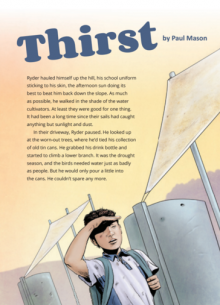
Thirst
by Paul Mason
illustrations by Andrew Burdan
In a realistic story set in the not-too-distant future, Paul Mason conveys a message that has increasing relevance today. The plot involves a family that cannot afford to buy water during a severe drought. Through implication, it appears that a single company owns the water and employs the parents of the family. When their neighbours receive a delivery of water, Ryder decides to take matters into his own hands.
-
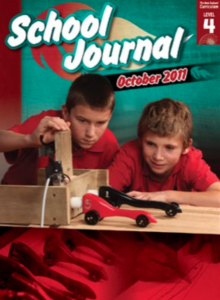
The Broad Street Killer
by Chris Nokes
This historical recount follows the efforts of Doctor John Snow to isolate the cause of a cholera epidemic in London during the nineteenth century. In his struggle to convince the establishment of his theories, he developed a “spot map”, which identified cluster patterns of cholera deaths in areas around water pumps. Although not recognised at the time, he is now considered a pioneer in the field of disease mapping.
-
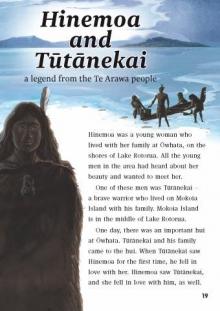
Hinemoa and Tūtānekai
A legend from the Te Arawa iwi
This text is a retelling of a legend of the Te Arawa people. It tells the love story of Hinemoa and Tūtānekai. Tūtānekai lives on Mokoia Island, separated from Hinemoa by the waters of Lake Rotorua. Hinemoa’s father does not want the two young people to be together and tries to stop them from meeting. But Hinemoa is determined and risks her life to swim across Lake Rotorua to be with Tūtānekai.
Gold 1
-
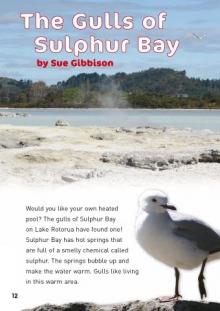
The Gulls of Sulphur Bay
by Sue Gibbison
Sulphur Bay, at the southern end of Lake Rotorua, is a wildlife reserve. Its hot springs make the area popular with many water birds, but the sulphur in the springs also causes some problems for them. This article describes how the gulls live in this unique environment. There are two other items in this Junior Journal linked to Lake Rotorua. They are “The Gulls of Mokoia Island” and a retelling of the legend of Hinemoa and Tūtānekai.
Gold 2
-
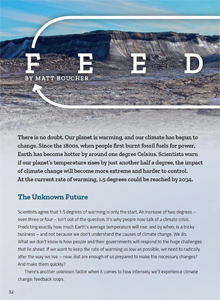
Feedback
by Matt Boucher
This article is a follow up to “Climate Change: Our Biggest Challenge”. It explains the phenomenon of feedback loops – positive feedback loops, which can cause climate change to accelerate, or negative loops, which can lessen the factors that cause change.
-
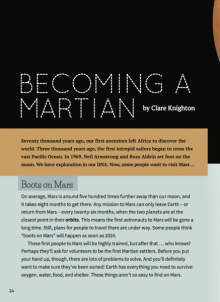
Becoming a Martian
by Clare Knighton
illustrated by Gavin Mouldey
“Becoming a Martian” is a challenging article that considers the possibility of humans living on Mars. The article begins with the concept “We have exploration in our DNA.” After reminding us of what humans need to survive on Earth (oxygen, water, food, and shelter) the writer explores each of these in relation to Mars, providing factual information about the planet, explaining the challenges of living there, and offering possible solutions.
-
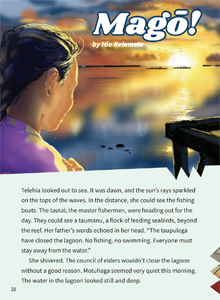
Magō!
by Hio Kelemete, illustrations by Vaitoa Baker
This is a humorous, entertaining story based on a true event. It provides examples of characterisation and dialogue as well as being a model for imaginative writing. This is a Pacific text. It provides a chance for Tokelauan and other Pacific students to see themselves and their culture reflected in the Journal.
-
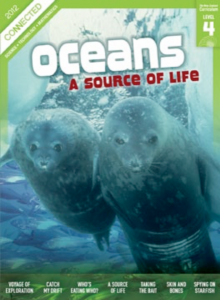
Voyage of Exploration
by Elinor Chisholm
In “Voyage of Exploration”, students read about the marine diversity in New Zealand’s territorial waters and the process that NIWA scientists use to classify organisms.
-
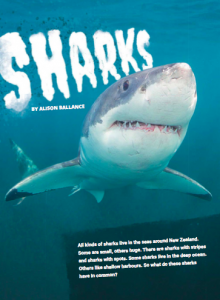
Sharks
by Alison Ballance
illustrated by Gavin Mouldey
This article provides information on sharks, focusing particularly on sharks found in New Zealand waters such as great white, rig, and deep-sea sharks.







 Literacy Online home
Literacy Online home
